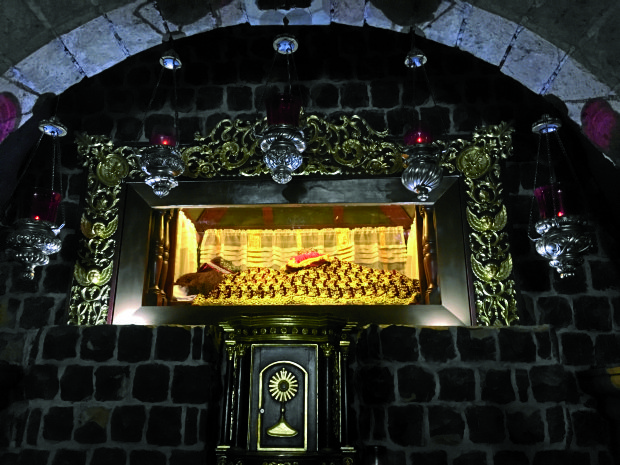‘Miracles’ attributed to 2 statues of the dead Christ in Pampanga City

SOURCE OF FAITH Miracles in the form of answered petitions and apparitions have been attributed to this replica of Apung Mamacalulu (The Dead Christ) in Angeles City. —TONETTE T. OREJAS
ANGELES CITY – A farmer suspected of being a Katipunero saved from execution by the Spaniards. A man healed of a kidney disease. A breast cancer patient’s encounter with a Good Samaritan who financed her surgery.
These are just some of the “miracles” attributed to two statues of the Dead Christ known by the same name, Apung Mamacalulu (Lord of Mercy), or referred to with the term of endearment Apu (elder), which draw believers to two churches here.
The first statue was made between 1828 and 1838 while the other one was made in 1930.
The older image was stolen in 1928 and a case was filed
in court involving it the following year.
Letters to Apu
A reproduction was made in 1930. A 25-year ban on Masses was imposed on the chapel that housed the images.
Article continues after this advertisementControversies aside, Apu continued to inspire devotion.
Article continues after this advertisementSr. Maria Socorro Garcia, O.P., said she believed that miracles attributed to Apu were the source of faith in the images, whether Apu at the Holy Rosary Parish Church or Apu at the Archdiocesan Shrine of Christ our Lord of the Holy Sepulcher in Lourdes Sur village.
Nina L.B. Tomen, writer and researcher, said the first miracle attributed to Apu was chronicled by the historian Daniel Dizon.
Dizon referred to it as the “mysterious salvation” of Roman “Duman” Payumo, a farmer and animal feed gatherer who had been mistaken for a Katipunero, a rebel against Spain.
According to Dizon’s account, Payumo was arrested, interrogated, beaten up and set for execution by musketry by the Spaniards.
Payumo escaped after “an intense and desperate” outburst to Apu outside a closed church on Oct. 25, 1897, the second day of the Quinario, or five-day devotion on the feast of Apu in the last week of October.
Begging in Kapampangan, Payumo implored, as recorded by Fr. Vicente Lapus: “Oh my Merciful Lord! Can’t you see me? They clubbed me and hit me in spite of my innocence! Now they’re even going to kill me! Oh, My God, turn your merciful gaze upon me! Please arise from your recline and come
out to me! Embrace me tightly and enfold me with your holy robe and save me, and cast away my executioners!”
Start of devotion
The rope loosened and Payumo ran until he fell into a 30-meter-deep locust trap that hid him from his captors for days.
“It signaled the beginning of an intense popular devotion,” wrote Dizon. The belief in Apu’s miracles stretched to the present time.
Sister Garcia, who handles administrative and pastoral work at the shrine, said she learned about the miracles through letters that devotees left for Apu.
“They thank him for healing, for paid debts or being able to work abroad,” Garcia said.
Apu gets more than a thousand letters weekly, she said.
Garcia has been unable to read all but those that she randomly picked asked for forgiveness, sought lifetime partners or children, expressed anger or appealed for help to pass exams.
The petitions and thanksgivings were written on just about any paper, even table napkins.
Blessings from Apu
Tomen’s planned monograph on Apu became a book in 2011 because, among other things, many devotees spoke of apparitions of Apu or blessings they received from him.
Florentino Feliciano related that his grandfather, Jose Dizon, and grandmother, Antonia Sanchez, of Magalang town welcomed an old man begging for food. The old man vanished after they handed him food and a blanket.
In Barangay Lourdes Sur, the site of the shrine, residents leave a glassful of water in the belief that Apu drinks water when he walks around at dusk.
Dizon said he was healed of a kidney ailment after his aunt, Carlota Henson, put pieces of cotton borrowed from Apu’s coffin on the spot where his kidney was.
Maria Mallari said her cyst disappeared after visiting Apu before surgery.
Efren Dizon said he survived different diseases due to Apu’s mercy.
After praying to Apu for days, Lilia Basco Mariano said a total stranger offered to pay for her breast cancer treatment.
Gloria Canlas said her daughter’s problem about visa to the United Kingdom was solved when she asked Apu for help.
In 2010, to care for the flock, Archbishop Paciano Aniceto lifted the ban on Masses imposed by Archbishop Oscar Cruz in 1985 because the chapel built by devotees on land owned by Clemente Dayrit was not church property.
A chapel was built to house the two images of Apu. Tomen said she did not think it mattered which image believers prayed to, “as long as it’s Apung Mamacalulu.”
Rites mark reverence for the two images. On Good Friday, the Apu from the shrine is brought to the church and returned after five days. The original Apu is the image borne in the procession.